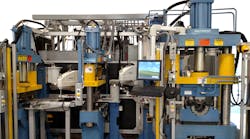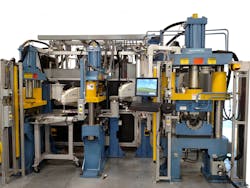Download this article as a .PDF
Plant managers and engineers in many industries are finding that productivity can be increased by tightly grouping the machinery that performs successive production steps into integrated workcells. This has been the experience at the Miba Bearings plant in McConnellsville, Ohio. The company recently installed a new bearing press workcell manufactured by Multipress Inc., Columbus, Ohio. The new workcell includes a shearing press, a blanking press, and a two-stage forming press with robotic part transfer for the manufacture of split bearings for crankshafts.
Miba has been using an array of discrete heavy stamping presses for bearing manufacture, but faced with the need to increase the plant’s manufacturing capacity while maintaining a high level of product quality, Plant Manager Jerry Donahue looked for the most efficient way of increasing the plant’s output. Plant Engineer Josh Gillespie specified a new bearing workcell that has a single programmable logic controller (PLC) commanding all three machines (shearing press, blanking press, and forming press), with a human-machine interface (HMI) that allows control of the whole manufacturing process by a single operator. The tight integration of the line, coupled with new-generation control technology, has cut production cycle times, while making better part-quality information available and reducing waste product. “We used to view bearing manufacture as a series of separate steps, but with production set up as a smooth flow, our productivity and quality have increased,” says Gillespie.
Maintaining production flexibility was also very important to the Miba Bearings team. “Currently we have 18 dies that we run on the press, some for single bearing halves and some for multiple halves. In the future, we plan to have up to 40 in,” says Gillespie.
The Bearing Forming Process
The key machine in the new workcell grouping is a servo press that makes crankshaft bearing halves with a single press cycle involving two steps: a preform step followed by a forming step. At the start of each cycle, a robot loads the bearing blank, which can vary in dimension from 2 in. × 3 in. up to 11 in. × 3 in., into the press and a laser scanner makes sure that the blank is seated properly. If the blank is not sitting in the fixture correctly, the press will inform the operator of an incorrectly set blank and stop the auto cycle until the part is properly placed.
Two linear hydraulic motion axes are involved in the forming operation, a preform cylinder and a forming cylinder. The preform cylinder is embedded in the press platen and extends to preform and set the blank in the tooling. Both the preform and final forming cylinder extend simultaneously. Once the blank is preformed, the preform cylinder retracts, the laser sensor confirms the proper position of the preformed blank, and then the final forming cylinder completes the cycle. All of these motions and checks are controlled by an RMC75E motion controller, manufactured by Delta Computer Systems Inc.
During the preform cycle, the pressure in the preform cylinder is monitored. If it is determined that the part is too hard and not bending properly, the operation will be aborted. As the forming process continues, the preform cylinder is retracted and the main forming cylinder completes the operation under closed-loop force control. When the proper force has been exerted on the part, the forming cylinder is retracted and the cycle is complete.
Selecting a Motion Controller
As described, the forming process requires precise control and monitoring of many factors through the operating cycle. In order to accomplish this, a motion controller was needed that has digital I/O capability in addition to interfaces to proportional servo valves and pressure and position sensors attached to the cylinders. To fill this need, Multipress, working with Delta Computer Systems distributor Advanced Industrial Products, Columbus, Ohio, selected the Delta RMC75E. “We’ve used Delta Computer Systems electrohydraulic motion controllers on many of our press designs over the last few years,” says Barney Raye, president of Multipress, “so selecting a Delta motion controller was a natural step for this new bearing press.”
Connecting the Motion Controller
The actual motion controller configuration used was the Delta RMC75E-AA2-AP2-D8-Q1. The position and force control of the forming platen are tracked by an analog position sensor and pressure sensor(s). Three pressure transducers are used in the system: one for pressure-force control of the forming cylinder, one for open-loop pump feedback, and one for overpressure sensing on the preform cylinder. Open-loop pump pressure control is provided to allow a better power match and energy efficiency during return stroke and idle. The Delta Q1 quadrature module allows the use of an encoder pendant to move the forming cylinder for tooling/part setup.
The motion controller uses its digital I/O interfaces to watch the placement robot to make sure that the blank is loaded correctly, and to monitor the preform operation to make sure that it completes satisfactorily. The controller aborts the operation if the blank isn’t loaded or preformed properly. Digital commands are also used to prompt the motion controller to confirm the operation of the jog pendant and to control the preform cylinder extension and retraction.
Other digital outputs from the motion controller are used to control a regeneration valve that shunts fluid from the rod end to the cap end of the forming cylinder when it needs to extend quickly, and a bypass valve that enables the cylinder to retract quickly. Multipress innovations, these additional valves help shorten cycle times.
The Delta controller communicates with the PLC over a built-in EtherNet/IP interface. Information that it receives includes input parameters used by the motion sequencing programs for press open and close positioning, and machine start and stop commands. At the end of a press cycle, the motion controller sends “cycle complete” info back to the PLC for relaying back to the HMI, which is also connected to the PLC. Besides the automatic manufacturing cycles, the machine was augmented with manual cycle controls, enabling the operator to verify the correct setup of the machine for processing a new part type.
Programming and Tuning the Motion
Delta Computer Systems motion controllers are supplied with a comprehensive application development environment, RMCTools, which is downloadable for free from the company’s website. The package provides access to the set of powerful built-in control functions in the motion controller, along with graphical tuning tools. “You can create plots of motion parameters versus time, and view entries in an event log, pinpointing exactly what’s happening as the machine runs,” says Mike Joyce, partner at Advanced Industrial Products. “EtherNet/IP communication makes program selection easy to do, which is helpful since we have 17 programs in all for the system and have 11 program triggers to monitor some 40 different variables, including cylinder pressures, homing status, etc.”
After setting up the motion steps using pre-programmed algorithms, using Delta’s tools to tune a motion system to optimize performance is a straightforward operation. “Delta’s Tuning Wizard is simple to use,” says Joyce. “We used it to initially set the gains for our control parameters. Then we ran the machine and did further tuning after it was running.” By producing a motion plot after each tuning step, Joyce could see how much improvement was made. “Plotting is the key to seeing how well the system responds,” he adds. “We can even make improvements to how the machine operates while it is running. This is not always possible with other motion controllers.”
Results
“Since we installed the new bearing press our operation has been running very smoothly,” says Miba’s Donahue. “Compared to a standard mechanical press the hydraulic servo press is slower, but it is compact and allows for automation,” notes Miba’s Gillespie. “Automation means we can do the entire process of shearing, blanking, and forming in one smooth flow, which eliminates putting the process parts in carts to tote to the next process. The reduction in parts handling reduces the cost of the part by close to 70%. As for quality, we have exceeded our customers’ expectations. We could not attain this level of quality otherwise, without re-machining the back of the part, which our customers would not accept.”





